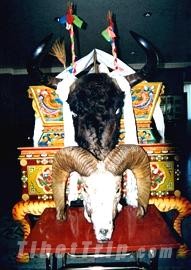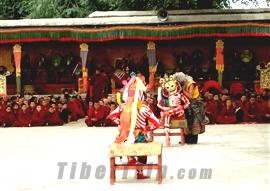 Primitive Ceremony
Primitive Ceremony
This primitive religious ceremony is used either in the indigenous religion, Bon or the later Buddhism in Tibet. Except for the blood sacrifice, the ceremony continues to be a local custom in the daily life of Tibetans.

Burning aromatic plants is a must in any case. It generally involves burning cypress or other leaves to please the deities. For blood sacrifices, offerings of animals like sheep, oxen and horses have been made to the deities. Because of the forbiddance of killing in Buddhism, this is no longer done and taken place by other ways. Chemar, a box containing Tsampa or other grains and stuck with Butter Sculptures , is the traditional offering to deities and is still popular today. Tibetans are also inclined to offer pure waters, mandalas, butter lamps, fruits, fragrant plants and jewels when worshipping. In addition, they also use embroideries, silks and other prized cloths to decorate Thangka , statues, sutras and protect the outside stupas. All of these practices are witness to their piety. The dance performed in the religious ceremony is called ' Changmo Dance ' , or 'Sorcerer's Dance'. Its purpose is to exorcise ghosts, and it is performed by lamas, wearing masks and robes decorated with colorful strips of cloths and weapons.

 Popular Religious Activities
Popular Religious Activities
Tibetan Buddhism has now become the dominant religion in Tibet. Average Tibetans have many religious activities to satisfy their faith, to name just a few: reciting sutras, murmuring mantras, hanging prayer flags, turning prayer wheels, circumambulating, worshipping and prostrating themselves. In the monasteries of Tibet, apart from the regular sutra reciting and debating, a religious festival will be held almost every month, which often attracts many locals to come to worship and see their performances. These festivals have now become the most important religious activities for both locals and lamas. The following are some of the most important religious festivals in Tibet.
|
Religious Festivals
|
Date (Tibetan Calendar)
|
Origination
|
Highlights of religious celebrations
|
|
Great Prayer Festival (Monlam)
|
Jan.4 – Jan.25
|
Tsong Khapa, the founder of Gelugpa, initiated the prayer ceremony to memorialize Sakyamuni, the founder of Buddhism in 1409.
|
1. Jokang Temple: Sutra debating competition for the application of the highest Buddhist degree.
2. Changmo Dance
3. Parading ceremony of Statue of Maitreya, or Buddha of the Future (Barkhor Street)
|
|
Butter Lantern Festival
|
Jan. 15
|
Tsong Khapa offered some Butter Sculptures to Sakyamuni in 1409.
|
1. Worshipping in the temples on the day
2. Displaying Butter Lamps and Sculptures in Barkhor Street in the night
|
|
Walk Around Mountain
(Buddha Bathing Festival)
|
Apr. 8
|
To memorize the birth of Sakyamuni and pray for harvest in one way.
|
1. Circumambulating around temples, mountains, cities, etc.
2. Performances of singing, dancing, Tibetan Opera...
(Wide spreading in Garze Tibetan Autonomous Prefecture, Sichuan)
|
|
Saka Dawa Festival
(Full Moon Day of the Saga Constellation)
|
Apr. 15
|
The supposed day of Sakyamuni's birth, ordination and nirvana
|
1. Burning aromatic plants
2. Circumambulation
3. Benefaction
|
|
Harvest Festival (Ongkor Festival)
|
June
(Time of the ripening of grains)
|
To pray for Harvest
|
1. Burning aromatic plants
2. Changmo Dance
3. Circumambulating around the field
|
|
Shoton Festival
|
Late June or Early July
|
Yogurt banquet for the monks and nuns after their food forbiddance before 17th century
|
1. Tibetans offer yogurts in temples
2. Tibetan Opera performances
3. Buddha Unveiling in Drepung Monastery, Lhasa
|
|
Butter Lamp Festival
|
Oct. 25
|
The day of the Nirvana of Tsong Khapa
|
1. Every house and temple burn many butter lamps
2. Circumambulating
3. Burning aromatic plants in temples
|
|
Great Prayer Festival of Winter
|
Dec. 23 – Dec. 29
|
To show the revival of Sakya Kingdom in 1474 originally
|
Changmo Dance in Sakya Monastery, Shigatse
|
|
Ghost Exorcising Festival
|
Dec. 29
|
To pray for good fortune in the next new year
|
Changmo Dance in Potala Palace
|
To learn more about Tibetan Festivals and their relative dates on the International Calendar, please refer to Festivals and Tibetan Calendar in this website.








